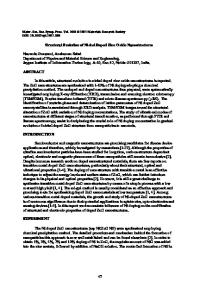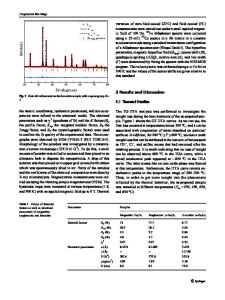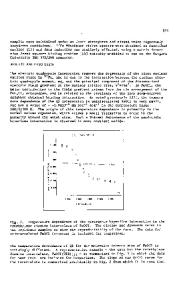Structural, Magnetic and Hyperfine Properties of Molybdenum Dioxide-Hematite Mixed Oxide Nanostructures
- PDF / 397,944 Bytes
- 6 Pages / 432 x 648 pts Page_size
- 104 Downloads / 286 Views
MRS Advances © 2018 Materials Research Society DOI: 10.1557/adv.2018.420
Structural, Magnetic and Hyperfine Properties of Molybdenum Dioxide-Hematite Mixed Oxide Nanostructures Richard Trotta1, Felicia Tolea2, Mihaela Valeanu2, Lucian Diamandescu2, Agnieszka Grabias3 and Monica Sorescu1 1
Duquesne University, Department of Physics, Pittsburgh, PA 15282, USA
2
National Institute of Materials Physics, P.O. Box MG-7, 077125 Bucharest-Magurele, Romania
3
Institute of Electronic Materials Technology, Wolczynska 133, 01-919 Warsaw, Poland
ABSTRACT
MoO2-Fe2O3 nanoparticle system was successfully synthesized by mechanochemical activation of MoO2 and α-Fe2O3 equimolar mixtures for 0-12 hours of ball milling time. The study aims at exploring the formation of magnetic oxide semiconductors at the nanoscale. X-ray powder diffraction (XRD), Mössbauer spectroscopy and magnetic measurements were used to study the phase evolution of MoO2-Fe2O3 nanoparticle system under the mechanochemical activation process. The Mössbauer studies showed that the spectrum of the mechanochemically activated composites evolved from a sextet for hematite to sextet and a doublet upon duration of the milling process with molybdenum dioxide. Recoilless fraction was determined using our dual absorber method and was found to decrease with increasing ball milling time. Magnetic measurements recorded at 5 and 300 K in an applied magnetic field of 50,000 Oe showed the magnetic properties in the antiferromagnetic and canted ferromagnetic states. The Morin transformation was evidenced by zero-field cooling-field cooling (ZFC-FC) measurements in 200 Oe and the transformation characteristic temperatures were shifted to lower values.
INTRODUCTION Molybdenum dioxide, MoO2 is currently the subject of intense investigations, due to its potential applications in energy-related materials, catalysis and electrochemistry. Thus, it has been proposed that surfactant-free self-assembly of reduced graphite oxide-MoO2 nanobelt composites can be used as electrode for lithiumion batteries [1]. In a different study, MoO2 nanoparticles were found to serve as high capacity intercalation anode for long-cycle lithium ion battery [2]. In [3], the MoO2/MoS2 electrode indicates higher specific capacitance than that of pure MoO 2 and pure MoS2. A facile hydrothermal method was proposed in [4] for the synthesis of MoO 2
2887
Downloaded from https://www.cambridge.org/core. University of Alberta Libraries, on 26 Nov 2018 at 20:48:43, subject to the Cambridge Core terms of use, available at https://www.cambridge.org/core/terms. https://doi.org/10.1557/adv.2018.420
nanoparticles for high-performance supercapacitor electrodes and photocatalysts. In addition, the synthesis and electrochemical properties of MoO 2/reduced graphene oxide hybrid for efficient anode of lithium ion battery has been reported [5]. A MoO 2-based cathode for CO2 and H2O electrolysis was obtained in [6]. Hierarchical MoO 2/N-doped carbon heteronanowires with high rate and improved long-term performance for li
Data Loading...











